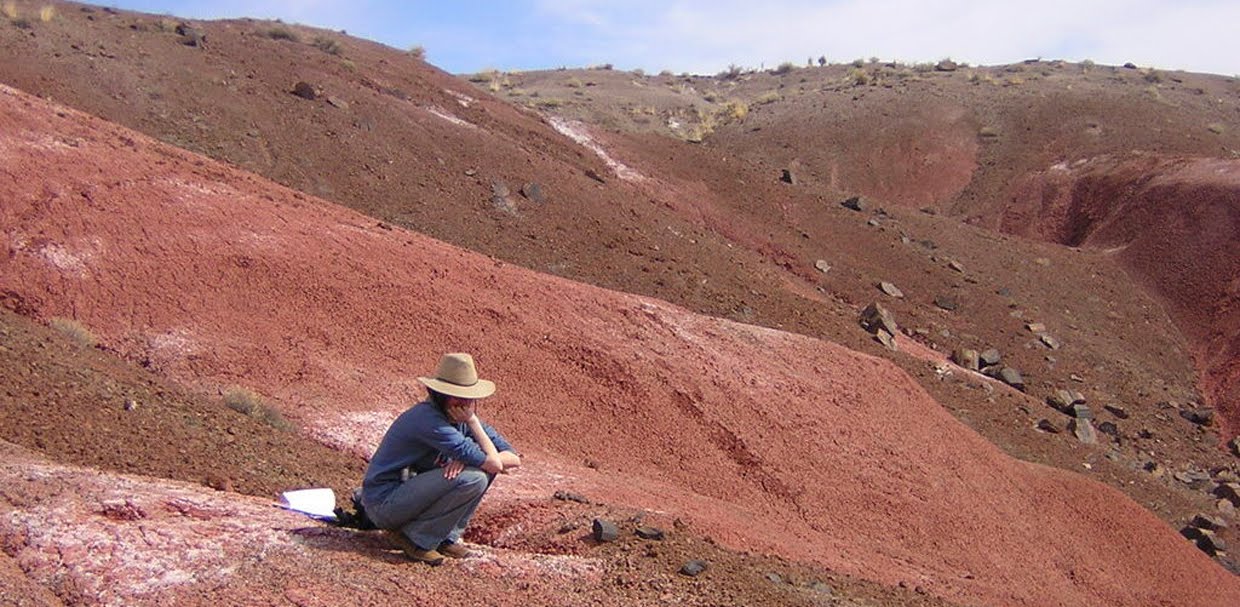Now flash forward to May:
I was a little surprised to see this still here, but why not? As we poked around on Tuesday, I got a private lesson in fossil hunting, including these handy tips:
Color probably won't help you. Objects such as petrified wood, bits of sandstone and chert, and carbonate nodules often share the same color as bone. Instead, look at the shape and texture of the pieces at your feet. It helps to have a knowledge of anatomy. Study the bones in the fossil prep lab in your spare time.
When you find something, don't remove it unless you're sure you can find the spot again. Don't make piles of bone pieces, as this could lead a future researcher on a wild goose chase, digging up the rock in search of the rest of the skeleton that seems to be weathering out. When it comes to deciding what to collect, consider the preservation quality, completeness and rarity of the specimen.
We found a few bits and pieces on Tuesday but the significant finds came Wednesday. I was set loose to prospect in an area that was being mapped, and wandered about a bit unsure of myself. I spent quite some time digging out bits of something I thought might be bone but which might also have been some concretions that formed around roots in the Triassic soils. I was not finding much of anything and for a couple hours was quite bored. But eventually the fact that I was outdoors in lovely and very quiet surroundings and able to explore whatever I wished became its own enjoyment and I started to find the job very relaxing.
And then after lunch, I did find something. It didn't require a tremendous amount of skill; in fact, I couldn't miss it. The previous day's advice about color suddenly seemed ironic.
These are the broken pieces of a scute (armor plate) of Typothorax, an aetosaur. The pieces are weathering out from under the sandstone body; tomorrow we'll go and dig and see how much there is. It's not likely that there's much more under there. Isolated aetosaur plates are much more common than complete skeletons. But one cool thing about this specimen is that the sand that was deposited on top of it by the ancient river formed a cast or impression of the scute, so the bottom of the sandstone looks like this:
I did a lot of walking that day and was amazed at how many different forms the desert could produce in just this one area. The colors of the rocks changed everywhere: purple, purple with white spots, red, white, striped red and white, green, orange. (I will talk later about what causes these colors.) And the bodies of sandstone weathered into different shapes everywhere. Out of all the hills and drainages I explored that afternoon, I found this particular pattern in just a couple square feet of it:
Here the sandstone has weathered into small spheres about the size of golf to tennis balls. Spheroidal weathering is common; any jagged edges on a newly broken rock have more surface area than the rest of the rock, and so receive the brunt of the exposure to the processes of chemical and physical weathering. Over time, rocks become round, even if all they're doing is sitting there. But, come on, how often do you see them looking like this without having been tumbled in a river? There were rounded boulders all over, but this was the only place I saw little rounded stones. Very odd.
That day I also found a spoon, blackened with age. Somebody's trash. I was about to bring it in when I realized it might be old enough to have turned from "trash" into "artifact." I was suddenly confused. Was I supposed to toss it in a dumpster or wrap it and mark its location in the GPS? In the end I just left it there, but after finding a couple parties interested in the spoon I believe we'll be GPSing and collecting it tomorrow after all.
The orientation I went through on Thursday wasn't quite as exciting, but I must say the facilities here are very nice. There's a community room with satellite TV, books and videos (I have not partaken of this yet), a workout room, a library, laundry room, barbecues, and a little post office.
The only other thing worth mentioning at this time was my being pistol-whipped by law enforcement. As we were dismissed from orientation I happened to lean back in my chair. One of our faithful servants of the law walked behind me and her pistol, hanging from her belt, clocked me in the head. She was very apologetic but of course I was more amused than anything else.
All is well and I am not having any troubles with the climate or anything else. Very tired. Looking forward to tomorrow. I will leave you with a picture from my evening ride the other night:

















